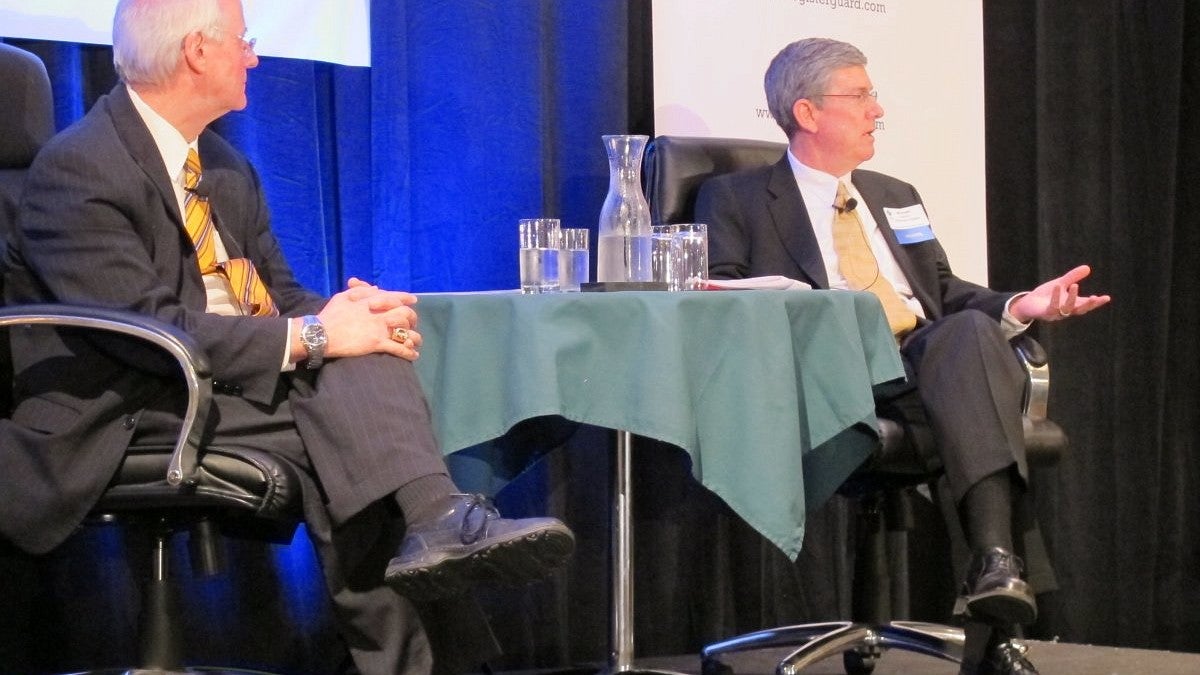With Oregon’s leading universities pulling together, there’s reason for optimism about the state economy in 2013, University of Oregon President Michael Gottfredson said Wednesday (March 20) during his keynote discussion at the 2013 Economic Forecast at the Hilton Eugene & Conference Center.
“We’re extremely optimistic,” Gottfredson told a collection of business leaders, elected officials and others numbering in the hundreds. “‘Bullish’ would be the word to use.”
The annual forecast, produced by The Eugene Area Chamber of Commerce with The Register-Guard, features experts who provide local and regional economic predictions for the coming year. As co-keynote speakers, Gottfredson and OSU President Edward Ray outlined the economic development roles of their institutions and urged business leaders and elected officials to work with the universities in enhancing quality of life for Oregonians.
Last year alone, the UO and OSU collectively brought in nearly $400 million in research dollars that result in discovery, innovation and economic activity for Oregonians.
As an example of what he called extensive collaboration between the two universities, Gottfredson cited the development of the Regional Accelerator and Innovation Network or RAIN, a joint effort to convert ideas to commercialization. The network will provide startup ventures with the human resources and infrastructure needed to succeed in Eugene/Springfield, Corvallis/Albany and the entire South Willamette Valley region.
“We have great research universities and a wonderful place to live,” Gottfredson said. “We need places for startups to exist short-term and we need to connect the entrepreneurial community with the invention community.”
In the competition with the nation’s top research universities to commercialize new ideas, Ray said OSU and UO will play to their strengths – OSU’s expertise in sustainable earth ecosystems and human health/wellness, and the UO’s in “green” chemistry, cognitive sciences, architecture and law. “How do you compete with the best in the class?” he asked. “You can’t be everything to everybody.”
The business-incubator network could generate more than 100 startups and 18,000 high-paying jobs over a decade, Ray said.
During an event that included presentations by the Eugene Water & Electric Board and a panel of economists, Gottfredson and Ray discussed their universities’ economic footprint, research accomplishments and collaborative successes.
Gottfredson noted the success of MitoSciences, a UO technology spinoff that has become a world leader in advancing efforts to understand the role of mitochondria – structures responsible for energy production in cells – in human diseases. Ray cited his university’s development of “transparent transistors,” expected to become a technological mainstay in the multi-billion-dollar flat-screen industry.
While the Ducks and the Beavers battle on the playing field, the presidents said their universities have teamed up for successes that include the Oregon Nanoscience and Microtechnologies Institute, the Center for Sustainable Materials Chemistry and the Lorry I. Lokey Laboratories.
The Orbis Cascade Alliance library system, for example, saves the state “hundreds of millions of dollars” by eliminating duplication of materials, Gottfredson said.
Key to the state’s economic success moving forward, Ray said, is recognition by business leaders and legislators that there must be a commitment to “long-term investments” rather than “short-term write-offs.”
Added Gottfredson: “Ed and I have the best jobs in the world. We work for institutions with one purpose only: enhancing quality of life for citizens of the state.”
—By Matt Cooper, UO Office of Strategic Communications


